Here's a great Dodge shop manual reference
from this link - http://workshop-manuals.com/dodge/grand_caravan/v6-3.6l/maintenance/vehicle_lifting/component_information/service_and_repair/
I just posted this in an old thread. I am creating this new post so it can be found easily.
If the link goes dead, it says -
WARNING: The hoisting and jack lifting points provided are for a complete vehicle. When the engine or rear suspension is removed from a vehicle, the center of gravity is altered making some hoisting conditions unstable. Properly support or secure vehicle to hoisting
device when these conditions exist. Failure to follow these instructions may result in serious or fatal injury.
CAUTION: Do not position hoisting device on any suspension component, including the front suspension crossmember, the rear leaf springs, and the rear axle. Do not hoist on the front and rear bumpers, the lower liftgate crossmember, the lower radiator crossmember,
the down standing flanges on the sill or the front engine mount.
The hoisting points are identified by S.A.E. inverted triangle hoisting symbols. The front hoisting points are at the bottom of the font rail below the
hoisting symbol approximately 250 mm behind the front suspension crossmember. When using outboard lift hoists, verify that the hoist lift pads have
been properly adjusted to eliminate contact between the hoist arm and the down standing flange on the sill. The rear hoisting points are the leaf spring
front mounting brackets. The hoist pad must be positioned to pick up the flanges on the bracket, not the leaf spring.
When servicing the leaf springs or the leaf spring mounting brackets, special provisions are required to support the rear of the vehicle. Position the rear
hoist pads under the horizontal surface on the bottom of the sill, inboard adjacent to the flange and centered fore/aft between the jacking indicator tabs on
the lower flange. DO NOT HOIST ON THE FLANGE. Place a soft pad between the hoist and the painted surface on the sill to avoid scratching the
finish.
------------
That doc references SAE symbols for lift points (inverted triangle).
One lift mfgr describes as follows -
NOTE: Some vehicles may have the manufacturer's Service Garage Lift Point locations identified by triangle shape marks on it's undercarriage (reference ANSI/SAE J21841992).
--------
On the image above, they refer to a "drive on lift" for lift positions marked as (1).
It took me a while to realize the are talking about the freaking wheels on the vehicle as lift points.
When you "drive on" the lift which is the style that has ramp things and it simply lifts the vehicle by the tires.
Common for muffler shops or someplace that isn't changing the tires or working on mechanical things that require puling the wheels off.
from this link - http://workshop-manuals.com/dodge/grand_caravan/v6-3.6l/maintenance/vehicle_lifting/component_information/service_and_repair/
I just posted this in an old thread. I am creating this new post so it can be found easily.
If the link goes dead, it says -
WARNING: The hoisting and jack lifting points provided are for a complete vehicle. When the engine or rear suspension is removed from a vehicle, the center of gravity is altered making some hoisting conditions unstable. Properly support or secure vehicle to hoisting
device when these conditions exist. Failure to follow these instructions may result in serious or fatal injury.
CAUTION: Do not position hoisting device on any suspension component, including the front suspension crossmember, the rear leaf springs, and the rear axle. Do not hoist on the front and rear bumpers, the lower liftgate crossmember, the lower radiator crossmember,
the down standing flanges on the sill or the front engine mount.
The hoisting points are identified by S.A.E. inverted triangle hoisting symbols. The front hoisting points are at the bottom of the font rail below the
hoisting symbol approximately 250 mm behind the front suspension crossmember. When using outboard lift hoists, verify that the hoist lift pads have
been properly adjusted to eliminate contact between the hoist arm and the down standing flange on the sill. The rear hoisting points are the leaf spring
front mounting brackets. The hoist pad must be positioned to pick up the flanges on the bracket, not the leaf spring.
When servicing the leaf springs or the leaf spring mounting brackets, special provisions are required to support the rear of the vehicle. Position the rear
hoist pads under the horizontal surface on the bottom of the sill, inboard adjacent to the flange and centered fore/aft between the jacking indicator tabs on
the lower flange. DO NOT HOIST ON THE FLANGE. Place a soft pad between the hoist and the painted surface on the sill to avoid scratching the
finish.
------------
That doc references SAE symbols for lift points (inverted triangle).
One lift mfgr describes as follows -
NOTE: Some vehicles may have the manufacturer's Service Garage Lift Point locations identified by triangle shape marks on it's undercarriage (reference ANSI/SAE J21841992).
--------
On the image above, they refer to a "drive on lift" for lift positions marked as (1).
It took me a while to realize the are talking about the freaking wheels on the vehicle as lift points.
When you "drive on" the lift which is the style that has ramp things and it simply lifts the vehicle by the tires.
Common for muffler shops or someplace that isn't changing the tires or working on mechanical things that require puling the wheels off.





